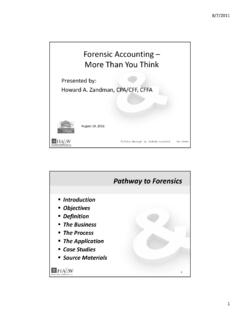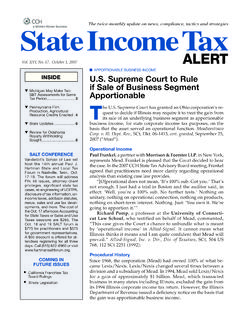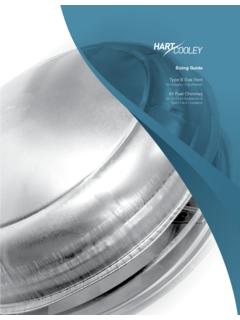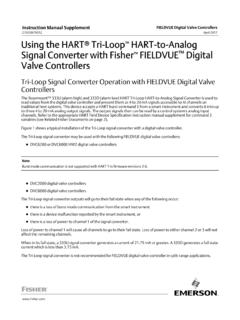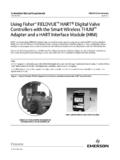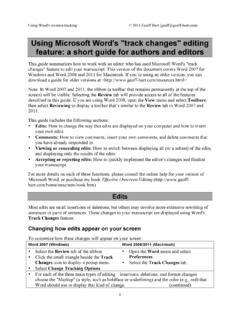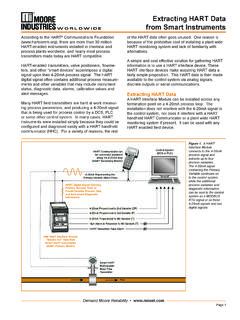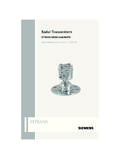Transcription of 16 Steps for Conducting an Audit By Leita Hart …
1 16 Steps for Conducting an Audit By Leita hart -Fanta, CPA This month let s start looking at the Steps of Conducting an Audit . I have discussed some of these Steps in more detail in previous newsletters. I ll refer you back to those old newsletters as they are applicable. Most traditional auditors think of an Audit in three phases planning, fieldwork, and reporting. I have broken those Steps down a little bit more. Steps 1-8 below are the planning Steps . Steps 9-12 are fieldwork and Steps 13-16 are reporting. You can successfully argue that planning, fieldwork, and reporting all blend together and each is an iterative process. But play along with me here! Here are the Steps to Conducting an Audit : 1. receive vague Audit assignment 2. gather information about Audit subject 3. determine Audit criteria 4. perform a risk assessment 5.
2 Refine Audit objective and sub-objectives 6. choose methodologies 7. budget each methodology 8. formalize the Audit plan 9. formalize the Audit program Audit Steps results in the working papers 12. review working papers 13. write findings 14. confer on findings with client 15. conclude 16. finalize report Let s talk about each step in turn: 1. Receive vague Audit assignment Some auditors have it easier than others. Financial auditors have it easier than many auditors because at least the whole universe isn t under examination only the financial statements of the entire universe! An initial vague Audit assignment for a financial Audit might sound like Express an opinion on the financial statements of the entity. And you could argue that compliance auditors have it pretty easy. But sometimes the compliance requirements are lengthy, vague, and require a lot of interpretation.
3 This makes a compliance auditor s job tough. An initial vague Audit assignment for a compliance Audit may sound something like, Determine if the entity is in compliance with state regulations and laws. But the hardest Audit type of all is a performance Audit . The initial vague assignment may not have any criteria built in. The auditor will have to work very hard to hone the objective before they can begin fieldwork. An initial vague Audit assignment for a performance Audit may sound like, Audit the effectiveness of the foster care program. EW. Scary. There is a lot of room for judgment and play in each Audit objective. Which financial balances are going to earn your attention? Not every item of expense or revenue deserves your precious Audit hours. Which compliance requirement? Which aspect of the foster care program? But before you can decide which areas deserve attention, you have to learn a bit more about their operations and systems and that is the bailiwick of step #2.
4 2. Gather information about the Audit subject The new risk assessment SASs SAS 104-SAS 111 and the Yellow Book are quite specific about this phase. They include a laundry list of all the questions you should seek to answer about Audit subjects before you can conduct a meaningful risk assessment. SAS 109 requires that auditors gain an understanding of the following 5 areas: 1. Industry, regulatory, and other external factors 2. Nature of the entity 3. Objectives and strategies 4. Measurement and review of financial performance 5. Internal controls The Yellow Book (Generally Accepted Government Auditing Standards) for performance audits require that you gain an understanding and I quote: Auditors should assess Audit risk and significance within the context of the Audit objectives by gaining an understanding of the following: a.
5 The nature and profile of the programs and the needs of potential users of the Audit report (see paragraphs through ); b. internal control as it relates to the specific objectives and scope of the Audit (see paragraphs through ); c. information systems controls for purposes of assessing Audit risk and planning the Audit within the context of the Audit objectives (see paragraphs through ); d. legal and regulatory requirements, contract provisions or grant agreements, potential fraud, or abuse that are significant within the context of the Audit objectives (see paragraphs through ); and e. the results of previous audits and attestation engagements that directly relate to the current Audit objectives (see paragraph ). This is actually a very risky part of the Audit for an auditor because you can spend a heck of a lot of time here.
6 This is sort of like the research phase for a PhD dissertation. We have all met someone who is close to getting their PhD, but can t because they are still researching the topic! Many marriages have fallen apart during the research phase and many audits drag on and on. I think this is one of the historic motivations behind auditors using SALY (Same as Last Year) procedures. With SALY there is no research phase and no danger of sucking up precious Audit hours in planning. (SALY, however, wastes precious time in the fieldwork phase because you end up doing unnecessary procedures.) I recommend that you allow only 5% of your total budget be spent in this phase. And if after the 5% is expended the auditor still doesn t feel ready to do a risk assessment give them another 1% - and then another 1% - and keep going in increments - until they are comfortable up to a max of 10% of the Audit budget.
7 But the danger is still there that you can get lost in this phase. So be careful. And after this phase is over many auditors have the tendency to feel a bit overwhelmed. They have so much info to work with now what? But have no fear step #4 (risk assessment) takes the chaos that you feel the disorder and disorientation you feel when you have too much information and concretizes it. The risk assessment phase is a structure that you can use to discard irrelevant information and highlight significant risks and areas of concern. 3. Determine Audit criteria During your information-gathering phase, you usually run across Audit criteria. It may very well have been defined at when you took on the assignment. What is an Audit criteria? It is the benchmark against which you evaluate the Audit subject. A criteria for a financial Audit is very straightforward it is GAAP (generally accepted accounting principles).
8 We are to express an opinion on whether the financial statements comply with the criteria the benchmark or GAAP. Now, if we were going to assess whether the foster care program is that is another matter. What defines effective? Is it that 90% of the foster children are safe? Is that the criteria you are going to measure the subject against? What defines safe ? How are we sure that foster care children are safe? This opens up a whole can of worms. And it is VERY important that you come to agreement with the client of the definition of effective before you proceed with your Audit . Otherwise you will get to the end of your engagement and report, You have failed because only 72% of your children are safe. And they say something like, No, we define safety differently than you do and from our calculations, 97% of our children are safe.
9 Your whole Audit was a bust. (Extreme example, I know.) An Audit without firm criteria is also known as a witch-hunt! So, financial auditors don t know how good they have it. Financial auditors agree with the client right up front about what they are intending to evaluate them GAAP. (The client may not understand GAAP but that is an issue for another newsletter.) 4. Perform a risk assessment There are two Steps to Conducting a risk assessment: 1. break the universe into bite-sized chunks 2. assess the risk of each chunk Now what is about the risk assessment SASs is that they divide financial statement universe up into bite sized chunks for you the chunks are the elements of the financial statements and the related management assertions. Other standard setting bodies such as the GAO (Yellow Book) and the Institute of Internal Auditors - don t give us much help.
10 We are left to our own devices. And believe me some auditors are more than qualified to create some wacky devices! Every internal Audit manager I talk to seems to have created or adopted a unique model for assessing risk. If you d like to see what others are doing see the RESOURCES page at . If you d like to share yours BRING IT ON! I ll put it up on the website. So on a performance Audit or a compliance Audit you must come up with your own way to divide the universe into bite-sized pieces. This can be one of the more challenging phases of the Audit . Simple example: on a compliance engagement, the chunks of the Audit universe might be the 30 compliance requirements for the grant. (In the next step of the risk assessment, we ll decide which 3 of the 30 chunks deserve our attention because we can t Audit all 30!) After the Enron debacle, all of the standard setting bodies have been pushing auditors to document their thought process regarding risk assessment.


![Lease Accounting CPE slides [Read-Only]](/cache/preview/b/e/e/e/3/4/1/5/thumb-beee3415077ca108d94220e1fd63be5b.jpg)



